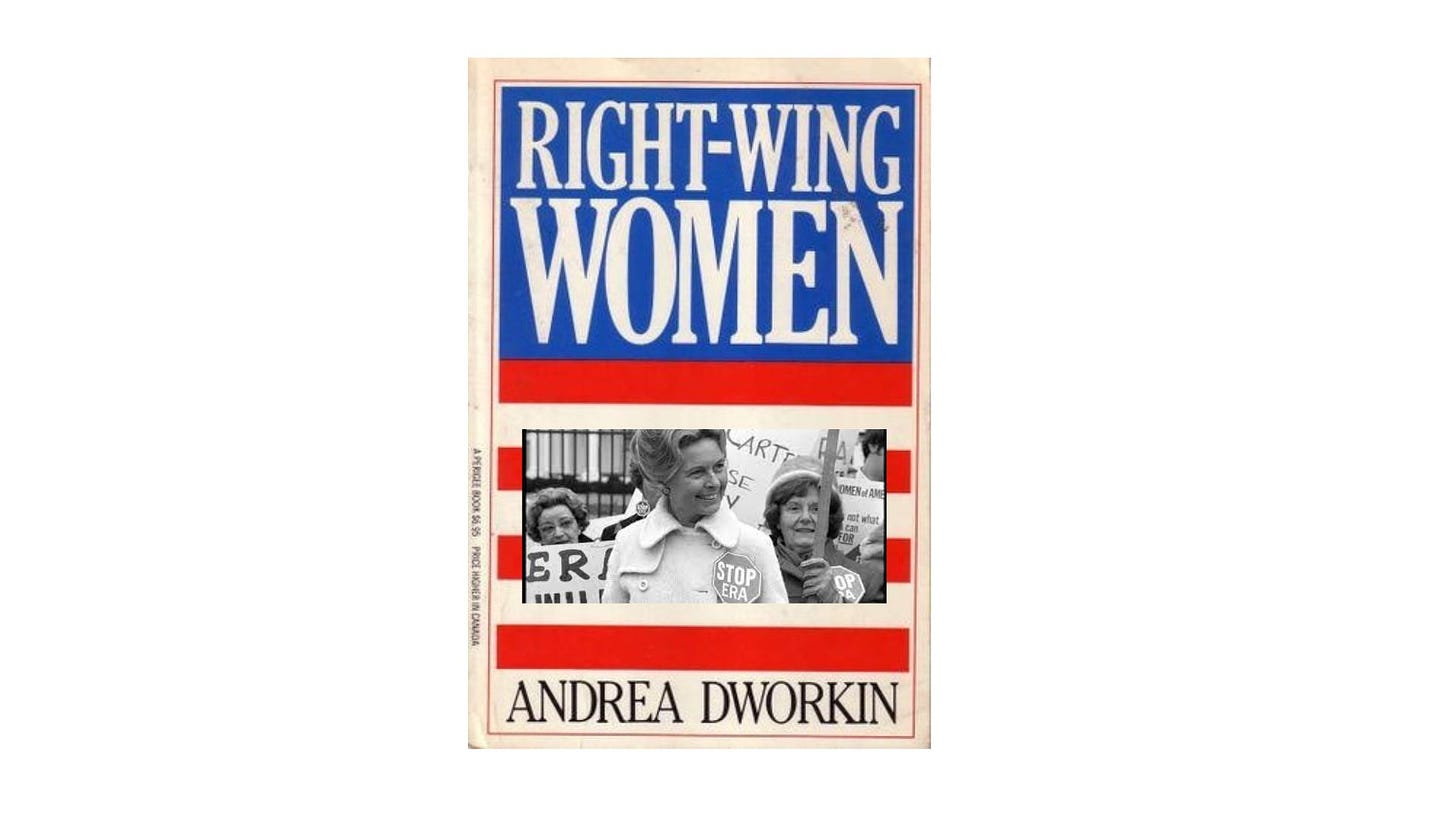Reading two outspoken women
Taking some liberty with our usual format, next time we’ll be considering the radically different viewpoints of contemporaries1 Andrea Dworkin and Phyllis Schlafly. While Dworkin is considered a radical feminist and Schlafly is famous for her campaign against the ratification of the Equal Rights Amendment, our discussion will explore their fundamentally different priors while noting where these different priors led to some similar viewpoints — including regarding the harms of pornography.
Feminist Fantasies
Feminist Fantasies, by Phyllis Schlafly (2003)
This is a collection of Schlafy’s essays written in the 1980s and 90s, in which she emphasizes the disappointments of the feminist movement as well as the dangers she perceives in the legal movement for sexual equality.
Among the “sexist” laws which the feminists expunged from the state statue books were the laws that forbade men to use obscene language in the presence of a woman. In the new era of feminism, women must be given their right to hear dirty jokes and vulgar language just like men. We’ve come a long way since the days of Golda Meir, who rejected feminism and said that no man ever told a dirty story in her presence.
The feminists want to make all federal and state laws gender neutral. They want to force us all conform to their agenda based on the unnatural ideology that there is no difference between men and women.
The feminists have had considerable success with their goals, due in part to the failure of men to understand that the feminist's’ goal is not fairness or equality of opportunity, but a gender-neutral society with feminists exercising the power.
— “Feminists Want to Have it Both Ways”
Last Days at Hot Slit
Last Days at Hot Slit: The Radical Feminism of Andrea Dworkin, by Andrea Dworkin (2019)
This collection includes selections from Dworkin’s books, including Woman Hating (1974), Our Blood (1976), Pornography: Men Possessing Women (1979-1989), Right-Wing Women (1983), and Intercourse (1987-1995).
The male sexual model is based on a polarization of humankind into man/woman, master/slave, aggressor/victim, active/passive. This male sexual model is now many thousands of years old. The very identity of men, their civil and economic power, the forms of government that they have developed, the wars they wage, are tied irrevocably together. All forms of dominance and submission, whether it be man over woman, white over black, boss over worker, rich over poor, are tied irrevocably to the sexual identities of men and are derived from the male sexual model. Once we grasp this, it becomes clear that in fact men own the sex act, the language which describes sex, the women whom they objectify. Men have written the scenario for any sexual fantasy you have ever had or any sexual act you have ever engaged in.
There is no freedom or justice in exchanging the female role for the male role. There is, no doubt about it, equality. There is no freedom or justice in using male language, the language of your oppressor, to describe sexuality. There is no freedom or justice or even common sense in developing a male sexual sensibility—a sexual sensibility which is aggressive, competitive, objectifying, quantity oriented. There is only equality. To believe that freedom or justice for women, or for any individual woman, can be found in mimicry of male sexuality is to delude oneself and to contribute to the oppression of one’s sisters.
[…] I want to suggest to you that a commitment to sexual equality with males, that is, to uniform character as of motion or surface, is a commitment to becoming the rich instead of the poor, the rapist instead of the raped, the murderer instead of the murdered. I want to ask you to make a different commitment—a commitment to the abolition of poverty, rape, and murder; that is, a commitment to ending the system of oppression called patriarchy; to ending the male sexual model itself.
— “Renouncing Sexual ‘Equality’” (from Our Blood)
Yes, Schlafly was born over 20 years earlier, but her public career as speaker and author is more or less contemporary with Dworkin’s period of activity. Schlafly died in 2016 at age 92; Dworkin died in 2005 at age 58.






